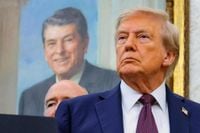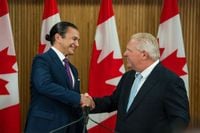President Donald Trump’s latest salvo in the ongoing trade dispute with Canada has sent shockwaves through both countries’ political and economic circles. On Saturday, October 25, 2025, Trump announced plans to hike tariffs on Canadian imports by an additional 10%. His reasoning? An anti-tariff television ad aired by the province of Ontario, which featured former President Ronald Reagan’s words criticizing tariffs—a move that Trump labeled as both fraudulent and hostile.
The ad in question ran during the first game of the World Series on Friday night, October 24, 2025, reaching a massive American audience. Ontario Premier Doug Ford, who authorized the campaign, had said the ads were intended to spark a conversation about the impact of tariffs on workers and businesses. “We’ve achieved our goal, having reached U.S. audiences at the highest levels,” Ford commented, noting that the province would pull the ad after the weekend. But the damage, at least in Trump’s eyes, was already done.
“Their Advertisement was to be taken down, IMMEDIATELY, but they let it run last night during the World Series, knowing that it was a FRAUD,” Trump posted on his Truth Social platform while en route to Malaysia aboard Air Force One. “Because of their serious misrepresentation of the facts, and hostile act, I am increasing the Tariff on Canada by 10% over and above what they are paying now.”
Trump’s threat sent Canadian officials scrambling. The White House did not immediately clarify what legal authority Trump would use to impose the new tariffs, nor did it specify when the increase would take effect or whether it would apply to all Canadian goods. The lack of detail added to the uncertainty already roiling the markets and political landscape.
Canada’s Trade Minister, Dominic LeBlanc, attempted to strike a conciliatory tone. In a social media post late Saturday, he wrote that Canada stands “ready to build on the progress made in constructive discussions with American counterparts over the course of recent weeks.” Notably, LeBlanc did not mention Trump’s tariff threat directly or the controversial ad, but he pointedly reminded the public that engagement with the U.S. administration is the federal government’s responsibility—a subtle effort to distance Ottawa from Ontario’s actions.
Ontario was not alone in defending the ad campaign. Manitoba Premier Wab Kinew weighed in, praising the ads for “accurately and powerfully” presenting Reagan’s views on tariffs. Kinew argued that Trump’s tariffs run counter to Reagan’s legacy and encouraged Ford to keep the ads on the air. “Ontario’s TV ads present Ronald Reagan’s views on tariffs accurately and powerfully. President Trump’s damaging tariffs go completely against Mr. Reagan’s legacy, and it’s clear that these ads are working,” Kinew declared on social media. He added, “If you throw a rock at a lake and you don’t hear a splash, you’ve probably missed. So to my good friend Doug Ford, keep the ads on TV. They’re effective and this country is behind you.”
However, not everyone agreed with Kinew’s assessment. The Ronald Reagan Presidential Foundation & Institute issued a statement asserting that the ads misrepresented Reagan’s address and that Ontario had not obtained permission to use his remarks. Trump himself insisted that the ad distorted Reagan’s position, even as a New York Times analysis found that, while the ad reordered parts of Reagan’s 1987 speech, it did not misrepresent or alter his core message.
The timing of the ad campaign was especially sensitive. Trump alleged that the ad was designed to influence the U.S. Supreme Court, which is set to hear arguments in November 2025 about whether Trump has the authority to impose sweeping tariffs—an issue that has already seen lower courts rule he exceeded his powers. The ads, which began airing the previous week, targeted right-leaning networks such as Newsmax and Fox News, both popular among Trump’s base.
For Canada, the stakes are enormous. More than three-quarters of Canadian exports go to the United States, with nearly CAD 3.6 billion (USD 2.7 billion) worth of goods and services crossing the border daily. Many Canadian products are already subject to a 35% tariff, with steel and aluminum facing rates as high as 50%. Energy products are taxed at a lower 10%, while other goods covered by the U.S.-Canada-Mexico Agreement (USMCA) are currently exempt. That agreement, negotiated by Trump during his first term but now under review, has become another point of contention as Trump’s stance has shifted from pride in the deal to open criticism.
Canadian Prime Minister Mark Carney, who has been working to reduce the economic pain inflicted by Trump’s tariffs, found himself sidelined at the Association of Southeast Asian Nations (ASEAN) summit in Malaysia. Both leaders were present, but Trump made it clear he had no intention of meeting Carney, telling reporters traveling with him that the Canadian leader would not be granted an audience.
The economic ripple effects of Trump’s announcement were immediate. Flavio Volpe, president of the Automotive Parts Manufacturers’ Association, warned that the additional tariffs would backfire on Americans. “To be clear, a TV commercial is about to cost American consumers about $50B because he’s mad,” Volpe posted on X (formerly Twitter). Canada’s auto sector, already battered by existing tariffs, stands to suffer even more, but Volpe’s message was clear: American consumers would also pay the price.
California Governor Gavin Newsom, a frequent Trump critic, echoed that sentiment, accusing Trump of “punishing the American people with higher costs” simply because “he got his feelings hurt.” The implication was that Trump’s decision had more to do with personal pique than sound economic policy.
Meanwhile, Conservative Leader Pierre Poilievre sought to turn the moment into a political opportunity, blaming Carney for failing to secure a better outcome in trade talks. Poilievre argued that Canada would not be facing the tariff hike if Carney had kept his promise to negotiate a win for Canadians.
At the heart of the dispute lies a fundamental disagreement about the legacy of Ronald Reagan and the role of tariffs in economic policy. Trump’s supporters argue that strong tariffs protect American jobs and industries, while critics—on both sides of the border—say that such measures ultimately harm consumers and disrupt vital trade relationships. The Reagan Foundation’s intervention added another layer of complexity, as both camps tried to claim the late president’s mantle for their own purposes.
As the dust settles, one thing is clear: the Canada-U.S. trade relationship is entering a new period of uncertainty. With the USMCA up for review and the Supreme Court set to rule on Trump’s tariff authority, the outcome of this dispute will have lasting consequences for businesses, workers, and consumers in both countries. For now, the fate of billions in cross-border trade hangs in the balance, hostage to political grievances and the power of a single televised ad.


